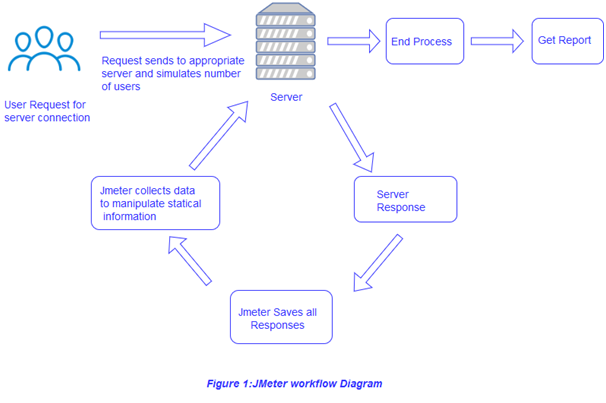Software Testing
JMeter1
SDLC models
Types of Testing
Types of Manual
White Box Techniques
Black Box Techniques
Types of Black Box
Types of Functional
Types of Non-functional
Test case development
Testing Techniques
Test Management
Defect Tracking
Other types of Testing
Software Testing Tools
Differences
Software Testing MCQ
Testing Interview Questions
JMeter Tutorial
Meter Tutorial

JMeter tutorial provides basic and advanced concepts of JMeter. Our JMeter tutorial is designed for beginners and professionals.
JMeter is an open-source Java application to analyze the performance of web application.
Our JMeter tutorial includes all topics of JMeter such as installation, Test Plan, Controllers, Listeners, Timers, ThreadGroup, etc.
What is JMeter?
JMeter also known as 'Apache JMeter' is an open source, 100% java based application with a graphical interface. It is designed to analyse and measure the performance and load functional behaviour of web application and variety of services.
JMeter is mainly used for testing Web application or FTP application but currently, it is applicable in functional testing, JDBC database connections, Web services, generic TCP connections and OS native processes. You can perform various testing activities like Performance, Load, Stress, Regression and Functional testing, in order to get accurate performance metrics against your web server.
JMeter was originally written and developed by Stefano Mazzocchi of the Apache Software Foundation. It was primarily written to test the performance of Apache JServ(currently known as Apache Tomcat project).Apache redesigned JMeter to enhance the GUI, to add more features and functional testing capabilities.
JMeter is not a browser and it doesn't render html pages like any browser does, rather it works on protocol level.
Following is a list of protocols supported by JMeter:
- Web Services - SOAP / XML-RPC
- Web - HTTP, HTTPS sites 'web 1.0' web 2.0 (ajax, flex and flex-ws-amf)
- Database via JDBC drivers
- Directory - LDAP
- Messaging oriented service via JMS
- Service - POP3, IMAP, SMTP
A web server carries a lot number of applications and users, so it is necessary to know that how capable a web server is to handle simultaneous users or applications. For example; how "javaTpoint" supporting server will perform when a number of users simultaneously access the javaTpoint website - basically have to do performance testing using performance testing tools like JMeter.
JMeter Features
Some of the most important features of JMeter are listed below:
- Open source application: JMeter is a free open source application which facilitatesusers or developers to use thesource code for developmentof other applications.
- User-friendly GUI: JMeter comes with simple and interactive GUI.
- Support various testing approach: JMeter supports various testing approach like Load Testing, Distributed Testing, and Functional Testing, etc.
- Platform independent: JMeter is written and developed using java, so it can run on any environment / workstation that accepts a Java virtual machine, for example - Windows, Linux, Mac, etc.
- Support various server types: JMeter is highly extensible and capable to load the performance test in different server types:
Web: HTTP, HTTPS, SOAP,
Database: JDBC, LDAP, JMS, and
Mail: POP3.
- Support multi-protocol: JMeter supports protocols such as HTTP, JDBC, LDAP, SOAP, JMS, and FTP.
- Simulation: JMeter can simulate multiple users by using virtual users or unique users in order to generate heavy load against web application under test.
- Framework: JMeter is a multi-threading framework which allows concurrent and simultaneous sampling of different functions by many or separate thread groups.
- Remote distributed testing: JMeter has Master-Slave concept for distributed testing where master will distribute tests among all slaves and slaves will execute scripts against your server.
- Test result visualization: Test results can be viewed in different formats like graph, table, tree, and report etc.
Working of JMeter
JMeter sends requests to a target server by simulating a group of users. Subsequently, data is collected to calculate statistics and display performance metrics of the target server through various formats.
JMeter work flow Diagram:

Prerequisite
Before learning JMeter, you must have the basic knowledge of Java.
Audience
Our JMeter tutorial is designed to help beginners and professionals.
Problem
We assure that you will not find any problem in this JMeter tutorial. But if there is any mistake, please post it in the contact form.

